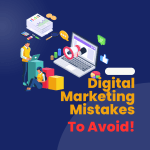
Email marketing for small business
Email marketing remains a vital tool for businesses to connect with their audience and drive conversions. When planning email marketing for small businesses, even the most well-intentioned email marketing campaigns can fall flat if they’re plagued with common mistakes. In this article, we’ll explore the key mistakes that might be hindering your email marketing success and provide actionable strategies to rectify them. So, let’s dive in and revamp your email marketing game!
Crafting Irresistible Subject Lines
Your email’s subject line is the first impression you make on your subscribers. It’s the gatekeeper that decides whether your email gets opened or banished to the dreaded spam folder. To revamp this crucial aspect, avoid using generic subject lines and embrace personalization. Tailor your subject lines to resonate with your audience’s pain points, desires, or emotions. Consider using humor, urgency, or curiosity to pique their interest and encourage opens.
Neglecting Mobile Optimization
With the majority of users checking emails on their mobile devices, neglecting mobile optimization can be a grave mistake. Ensure that your emails are responsive and display correctly across various screen sizes. Use concise yet compelling content that fits mobile screens, and optimize your images for quick loading. A seamless mobile experience can significantly boost your email engagement.
Overlooking Segmentation
Sending the same email to your entire subscriber list might lead to disengagement. Segment your audience based on factors like demographics, purchase history, and engagement level. By delivering targeted content that resonates with specific segments, you can enhance relevancy and drive higher conversions. Personalized recommendations and offers can work wonders for your email marketing success.
Skimping on A/B Testing
A/B testing is your secret weapon for optimizing email campaigns. Failing to conduct A/B tests means missing out on valuable insights. Test different elements such as subject lines, call-to-action buttons, and visuals to determine what resonates best with your audience. Use data-driven results to refine your emails and boost their effectiveness over time.
Skimping on A/B testing is a grave mistake that can significantly hinder the success of your email marketing campaigns. A/B testing, also known as split testing, is a powerful technique that involves sending two different versions of an email to a subset of your audience to determine which version performs better in terms of open rates, click-through rates, and conversions. This process allows you to make data-driven decisions and optimize your emails for maximum impact.
By neglecting A/B testing, you’re essentially flying blind without valuable insights into what resonates with your audience. Here’s why A/B testing is crucial and how it can transform your email marketing efforts:
Unveiling Audience Preferences: A/B testing enables you to understand what elements of your email capture your audience’s attention. You can test different subject lines, email copy, visuals, and even call-to-action buttons. This knowledge empowers you to tailor your emails to your audience’s preferences, leading to higher engagement.
Improving Open Rates: Your subject line is the first thing recipients see, and a small tweak can make a significant difference in open rates. Through A/B testing, you can experiment with various subject lines to identify which ones encourage more opens. This can help you refine your messaging strategy over time.
Enhancing Click-Through Rates: A/B testing also extends to the content within your email. Testing different layouts, placement of links, and visuals can impact click-through rates. By analyzing the results, you can pinpoint the elements that encourage recipients to take action.
Optimizing Conversion Rates: The ultimate goal of most email campaigns is to drive conversions. A/B testing allows you to fine-tune your emails to prompt the desired actions, whether it’s making a purchase, signing up for a webinar, or downloading a resource.
Refining Design Elements: Visual elements such as images, colors, and fonts play a role in conveying your brand’s identity. A/B testing helps you identify which design choices resonate best with your audience, ensuring a consistent and appealing visual experience.
Data-Driven Decision-Making: A/B testing takes the guesswork out of your email marketing strategy. Instead of relying on assumptions, you can base your decisions on concrete data and trends, leading to more effective campaigns.
Continuous Improvement: The digital landscape is ever-evolving, and audience preferences can change over time. A/B testing isn’t a one-time endeavor; it’s an ongoing process that allows you to adapt to shifting trends and keep your emails relevant.
Incorporating A/B testing into your email marketing strategy might require a bit more effort, but the results are well worth it. Start by identifying the elements you want to test and create two versions of your email with variations in those elements. Then, send each version to a subset of your audience and track the performance metrics.
Remember that A/B testing isn’t about finding a single “winning” version but rather about continuously optimizing and learning from the data. Over time, you’ll develop a deeper understanding of your audience’s preferences and behaviors, enabling you to create more engaging and effective email campaigns that drive better results.
So, if you’ve been skimping on A/B testing, it’s time to make it an integral part of your email marketing strategy. The insights you gain will empower you to make informed decisions, refine your campaigns, and achieve better outcomes.
Ignoring the Power of Automation
Automation can revolutionize your email marketing by delivering the right message at the right time. Set up automated workflows for welcoming new subscribers, nurturing leads, and re-engaging dormant customers. Personalized drip campaigns can build stronger relationships and guide subscribers through the customer journey without overwhelming them.
Email marketing automation has proven to be a game-changer for businesses of all sizes. Ignoring the power of automation can result in missed opportunities to engage customers, nurture leads, and drive conversions. Here are some key points highlighting the significance of email marketing automation:
Improved Engagement and Personalization: According to a report by Epsilon, automated emails have 86% higher open rates and 196% higher click-through rates compared to traditional, non-automated emails. Automation allows you to deliver personalized content based on user behavior, preferences, and demographics, increasing the relevance of your messages and enhancing engagement.
Increased Revenue and Conversions: In a study by DMA, it was found that segmented and targeted emails generate 58% of all revenue. Automation enables you to send timely, relevant messages that guide subscribers through the sales funnel. By delivering the right content at the right time, you can significantly boost your conversion rates.
Enhanced Customer Journey: Research by Aberdeen Group reveals that companies using email automation achieve 50% more sales-ready leads at a 33% lower cost. Automated workflows allow you to create a seamless customer journey, from welcome emails for new subscribers to abandoned cart reminders and post-purchase follow-ups.
Time and Resource Efficiency: Automation saves valuable time and resources by streamlining repetitive tasks. You can set up drip campaigns, trigger emails based on user actions, and schedule emails in advance. This efficiency allows your marketing team to focus on strategy and creativity.
Reactivation of Dormant Subscribers: According to a study by Return Path, re-engagement emails sent through automation can result in a 45% open rate and a 6.5% click-through rate. Automation enables you to win back subscribers who might have lost interest, turning them into active and engaged customers once again.
Consistency in Communication: A consistent presence is essential for maintaining brand awareness and customer loyalty. MarketingSherpa’s research indicates that 49% of businesses use some form of email automation, ensuring that subscribers receive timely updates, offers, and information.
Data-Driven Insights: The ability to track and analyze the performance of automated emails provides valuable insights into subscriber behavior. Metrics such as open rates, click-through rates, and conversion rates help you refine your strategy and optimize future campaigns.
Personalized Recommendations: Research by SmarterHQ shows that 72% of consumers only engage with personalized marketing messages. Email automation enables you to leverage behavioral data to provide tailored product recommendations, driving cross-selling and upselling opportunities.
Neglecting Unsubscribe Requests
While it’s disheartening to see subscribers leave, ignoring unsubscribe requests can harm your sender reputation. Make the unsubscribe process easy and hassle-free. Instead of losing a subscriber forever, offer options to adjust email frequency or change preferences. A respectful approach to unsubscribes can leave a positive impression on those who may return in the future.
Disregarding Analytics and Insights
Email marketing is a constant learning process, and analytics are your compass. Neglecting to analyze metrics like open rates, click-through rates, and conversion rates can blind you to your campaign’s performance. Regularly review these insights to identify trends, uncover areas for improvement, and make data-driven decisions to enhance your email strategy.
Conclusion
When planning email marketing for small businesses, rectifying these common mistakes can give your campaigns the much-needed revamp they deserve. Craft compelling subject lines, optimize for mobile, embrace segmentation, harness the power of A/B testing and automation, handle unsubscribe requests gracefully, and continuously analyze your efforts. By addressing these aspects, you’ll be well on your way to reaping the rewards of a revamped email marketing strategy.
FAQs
Q1: How often should I send marketing emails? A1: The frequency of your emails depends on your audience and the value you provide. Test different frequencies to find the sweet spot between engagement and not overwhelming your subscribers.
Q2: Can I recover from a high unsubscribe rate? A2: Yes, you can. Focus on improving your email quality, relevance, and personalization. Over time, your unsubscribe rate can decrease as you build stronger connections.
Q3: What’s the importance of open rates? A3: Open rates indicate how effective your subject lines and sender name are. Low open rates might suggest a need to refine your subject lines for better engagement.
Q4: How do I start with email automation? A4: Begin by identifying key points in your customer journey. Set up automated emails for onboarding, abandoned carts, and follow-ups based on user actions.
Q5: Is it better to have plain text or visually rich emails? A5: It depends on your audience and the message you’re conveying. Both have their merits. Test to see which format resonates best with your subscribers.









[…] an effective email campaign starts with understanding your […]